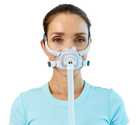CPAP therapy improves your quality of life by letting you sleep soundly at night and leading a healthier lifestyle. Unfortunately, the nose sores you get in your daily life after using the mask at night make the task a bit harder.
While experienced CPAP therapy patients have found ways to tackle them, the new users are still struggling. If you don’t know how to prevent nose sores from a CPAP mask, you feel you’re on the verge of abandoning therapy altogether.
Let’s improve the situation before it gets to that.
5 Ways to Prevent Nose Sores from CPAP Masks
Buy a mask liner
If you are experiencing nose bridge sores rather than a dry nasal passage, mask liners are an easy solution. The softer fabric of a mask liner acts as a barrier between the mask cushion and the bridge of your nose. As a result, you don’t feel the pressure of the nose mask, thus reducing the soreness.
You don’t get red marks on your skin from the mask, either. The liners also help prevent air leaks by providing an extra barrier.
Clean your CPAP mask regularly
Dirty CPAP masks are a big but easily missed reason for a sore nose bridge.
Do you often find yourself adjusting your headgear? Tightening it every time and thus putting too much pressure on your nose? Because dust and bacteria are accumulating on the mask, that part might slip from its appropriate place.
Clean your CPAP mask as often as you can. Additionally, you are supposed to replace them after 90 days.
Use nasal lubricant
If the nose soreness is inside your nasal passage, use a nasal passage moisturizer. These lubricants supply moisture to your nose while you are getting CPAP therapy. As a result, your nose doesn’t get dry, so you don’t feel the same irritation in the morning.
Use heated humidifier
A heated humidifier works by heating up the water in the water chamber. As a result, the CPAP air you get is humid, which means it has adequate moisture. When this air reaches your nasal passage, it provides the moisture along with the air, thus preventing your nose from getting dry.
Even sore throat and dry mouth are prevented with a heated humidifier. You should always look for a CPAP machine that has a heated humidifier. Research proves that sleep apnea patients are more likely to continue with therapy if their CPAP machine has a heated humidifier.
Use a heated tubing
Like a heated humidifier, a heated tubing has the same role of mixing moisture into the air. Using only a heated humidifier with a regular tubing can lead to unnecessary condensation in the tubing called rainout.
If you use a heated tubing and humidifier combination, both parts can work in tangent with each other.
Use different CPAP mask
If nothing else works out, you should change your CPAP mask. You want a mask that sits comfortably on your face.
For sore nose bridges, the mask should not feel too tight or too loose. You might find a nasal pillow mask more comfortable since it does not take over your entire face. It also weighs less, which is great since the pressure can be one of the causes of nose irritation.
What causes nose sores from a CPAP mask?
The CPAP machine sends continuous air flow to your airways. However, without a heated humidifier or tubing, it can be dry. A dry nose can hurt. However, if the bridge of your nose is sore, it’s because your mask is too tight.
You might also have some sort of allergy to the material of the mask. It would be a good idea to check in with your doctor on the issue.
A dirty mask might also cause your nose to turn red due to irritants being caught in the mask cushion.
Final Thoughts
Even if you can’t buy a machine with a humidifier, using nose lubricants before you begin your CPAP therapy can prevent inner passage dryness. Keep your mask and tubing clean to prevent any bacteria infestation, leading to sores.

















































































